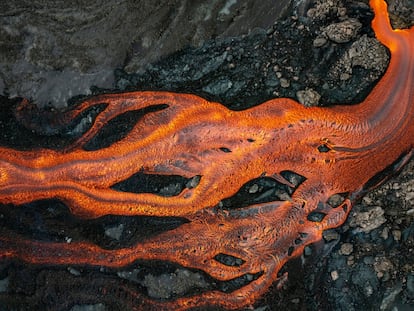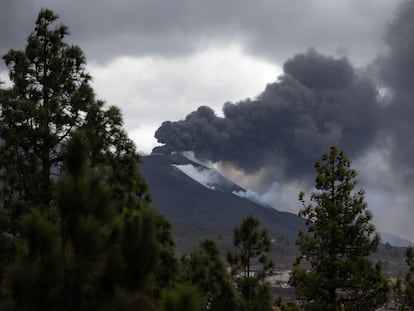Lockdown lifted for 33,000 confined on La Palma due to bad air quality from volcano
The eruption is now the longest on record on the Spanish island, where residents have been struggling with lava and ash emissions for 85 days


Authorities in La Palma, one of Spain’s Canary Islands, on Monday afternoon lifted stay-at-home orders for around 33,000 people who’d been told to remain indoors due to the “extremely unfavorable” air quality caused by a volcanic eruption that began nearly three months ago.
The order was issued at 8.45 am on Monday morning by the Volcano Risk Prevention Plan of the Canary Islands (Pevolca), which is overseeing the crisis, in response to the high concentration of sulfur dioxide on the western side of the island. It affected the municipalities of Los Llanos de Aridane, El Paso and Tazacorte, which are home to 40% of La Palma’s population.
The Canary Islands’ security and emergencies department had told parents not to pick up their children from school due to high levels of sulfur dioxide in the air. But the lockdown was lifted at 1pm local time. The Cabildo (island authority) tweeted that “the confinement decreed this morning for the municipalities of Los Llanos de Aridane, El Paso and Tazacorte has been lifted following an improvement in air quality.”
Record duration

Monday marked day 85 of the eruption in the Cumbre Vieja natural park, making it the longest one on record on La Palma, which is part of a volcanic archipelago located off the northwestern coast of Africa. Until now, the record had been held by the Tahuya volcano, which spewed lava for 84 days in the year 1585.
In the history of the Canary Islands, there are only three other eruptions that have lasted longer: the 1824 eruption of the Tao or del Clérigo volcano on the island of Lanzarote (86 days), the 1798 Narices del Teide eruption on Lanzarote (99 days) and the 1730 Timanfaya eruption on Tenerife, which lasted six years.
The new volcano on La Palma is close to surpassing the closest two records. Pevolca warned this past weekend that the eruption will go on as long as there continue to be vibrations caused by the flow of gas and magma and sulfur dioxide emissions, which indicate that there is magma close to the surface. This is the case even though the island has recorded a drop in seismic activity.
The current eruption will also go down in the history books as the most destructive to hit the archipelago. The latest damage assessment shows 1,193 hectares of land and over 3,000 buildings affected by the lava, according to the European satellite program Copernicus. And there are still 547 people unable to return to their homes, according to the emergency services of the Canary Islands.
Realizando termografía en estos momentos bajo una intensa lluvia de piroclastos / Performing thermography right now under a heavy rain of pyroclasts pic.twitter.com/dISI2q7B6s
— INVOLCAN (@involcan) December 13, 2021
One of the most widely accepted theories of the creation of the Canary Islands holds that the archipelago sits over the African Plate, which moves over the Earth’s mantle at a speed comparable to the growth of fingernails, and that around 20 million years ago this plate began drifting over a “hotspot” that injected magma and led to the creation of the first and oldest islands: Fuerteventura and Lanzarote. La Palma and El Hierro are the youngest, at 1.8 million and 1.2 million years of age, respectively. These islands are still over the hotspot, which is why they have active volcanos that are making them grow in size.
There are historical records for the last six centuries, when more than 20 eruptions were recorded in the Canary Islands. The current eruption is located inside the Cumbre Vieja natural park, a very active volcanic range where two out of the three most-recent eruptions in the Canaries were recorded: San Juan volcano in 1949 and Teneguía volcano in 1971.
Tu suscripción se está usando en otro dispositivo
¿Quieres añadir otro usuario a tu suscripción?
Si continúas leyendo en este dispositivo, no se podrá leer en el otro.
FlechaTu suscripción se está usando en otro dispositivo y solo puedes acceder a EL PAÍS desde un dispositivo a la vez.
Si quieres compartir tu cuenta, cambia tu suscripción a la modalidad Premium, así podrás añadir otro usuario. Cada uno accederá con su propia cuenta de email, lo que os permitirá personalizar vuestra experiencia en EL PAÍS.
¿Tienes una suscripción de empresa? Accede aquí para contratar más cuentas.
En el caso de no saber quién está usando tu cuenta, te recomendamos cambiar tu contraseña aquí.
Si decides continuar compartiendo tu cuenta, este mensaje se mostrará en tu dispositivo y en el de la otra persona que está usando tu cuenta de forma indefinida, afectando a tu experiencia de lectura. Puedes consultar aquí los términos y condiciones de la suscripción digital.
More information
Últimas noticias
Welcome to the post-religion era: The idea of Christianity as the absolute truth has become obsolete
‘I thought you would like it’: The risky sexual practice popularized by TV shows and TikTok
The digitalization of tourism: ‘They promise experiences and gave us the worst possible one’
Mexican peso defies uncertainty with forecasts of a new period of stability in 2026
Most viewed
- Sinaloa Cartel war is taking its toll on Los Chapitos
- Oona Chaplin: ‘I told James Cameron that I was living in a treehouse and starting a permaculture project with a friend’
- Reinhard Genzel, Nobel laureate in physics: ‘One-minute videos will never give you the truth’
- Why the price of coffee has skyrocketed: from Brazilian plantations to specialty coffee houses
- Silver prices are going crazy: This is what’s fueling the rally










































